Smooth ceiling is one of the components of modern repairs. One of the methods of alignment is the plaster ceiling. The technology is not very complicated, but requires accuracy. With modern materials and tools, this work can be done with your own hands. It cannot be said that it will be easy, but it is possible to cope without the skills of plaster.
With lighthouses or without
There are two technology plaster ceiling - with lighthouses and without. Right - to do with lighthouses. Then the surface of the ceiling is obtained in the same plane. However, there are ceilings with a very large height difference. Put the ceiling layer of plaster thickness of 5 cm dangerous: may fall. Even if you make several layers with the application of the primer after everyone, the guarantee that such a large layer will hold on, there is still no.
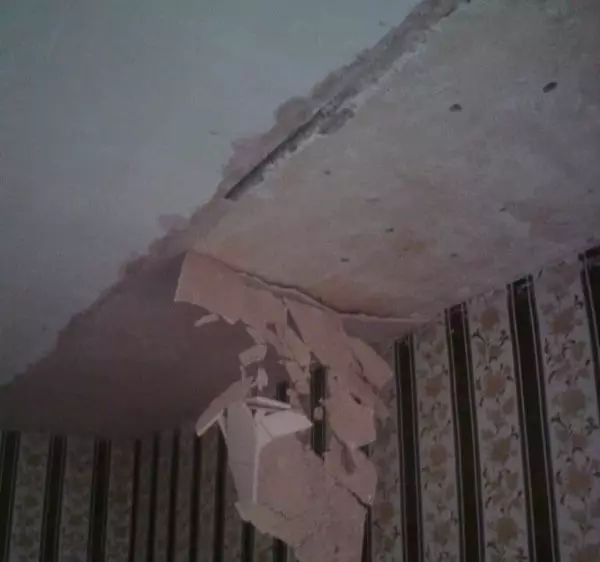
Incorrectly applied plaster can fall off
In general, with a large curvature of ceilings, it is recommended to align them with suspended ceilings from drywall, but not all rooms allow you to "steal" about 10 cm of height. In this case, you can do wrong - to launch the ceiling without lighthouses.
The whole idea is to make a ceiling on some plot. It will not have noticeable drops, visually will look like smooth. And the fact that in different angles the distance to the floor will be different for several centimeters, "on the eye" cannot be determined. With this technology, the main task is to make a smooth bog of the ceiling and walls. This line is very clearly tracked and should be straight. If you choose this ceiling plaster technology, you need to start plastering from the walls to the center.
The better plastering
For plastering ceiling, you can use a conventional cement-sandy solution, or the same, but with the addition of lime. But it is desirable to apply a small layer. At least such a mixture is the cheapest, recently it is used infrequently - can fall or go cracks.The place of the usual solution was taken by plaster based on polymers, which have better clutch, less often gives cracks. Their disadvantage is a high price. But redo the ceiling after the applied layer falls, it is not cheaper. Therefore, they prefer to immediately make the stream of flow from modern mixes. Some types of similar materials recommended for ceilings are shown in the table.
| Name | Purpose | Color | Layer thickness | Type of binder |
|---|---|---|---|---|
| Plastering mix of Knauf Rotband | To shock the smooth surfaces of the walls and the ceiling | White gray | 5-50 mm | Gypsum with polymer additives |
| Plaster-adhesive mix of Knauf Seven | To restore old plaster surfaces, including facades | Grey | Portland cement with polymer additives and reinforcing fibers | |
| Stucco Bergauf Bau Interier | For plaster indoors with normal humidity | Gray / White | 5-40 mm | Cement with polymer additives and perlite filler |
| Plaster | For interior facilities with normal humidity | 5-50 mm | Based on plaster with chemical and mineral additives |
If the experience of plaster works is small, when choosing a composition, pay attention to the time until the released solution is frozen. During this period, it is necessary to align the whole solution, because then he begins to fit, loses elasticity. Of the longer life of the "life" of the waves, which are shown in the table. But not everyone likes to work with it, many say that with Knauff is easier, although they are less than the time of frozen - 50-60 minutes, but it is more than enough even in the absence of experience.
Article on the topic: Gas column in the bathroom
Primer, why need and what better
Normal ceiling plaster without thorough primer you will not work. It improves the adhesion (grip) of the plaster mixture with the basis. Basically, all problems with falling and peeling trim on the ceiling due to the fact that the basis has not been trunk. Because this stage do not miss. More in addition, if there are several layers of plaster, each of them is desirable to treat primer (with full drying).
First, we prepare the base - we clean from old coatings, and then we proceed with the primer. For this, the composition is pouring into a painting bath, take a roller on the length of the handle (telescopic barbell) and distribute the composition on the ceiling. If there are some recesses - notches, defects on the surface of the ceiling, in which the roller is simply not placed, they are pre-processing with a brush dipped in primer.
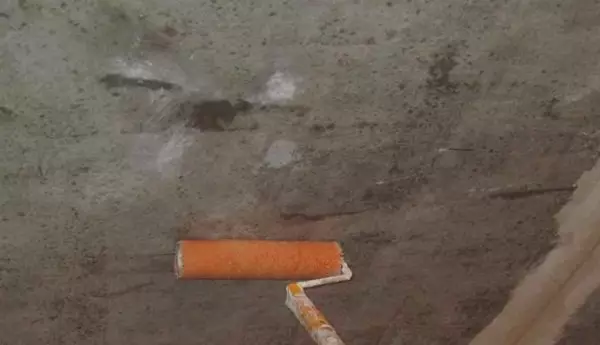
Ceiling primer before plaster
Now about what a primer for the ceiling is better. According to the masters, this "concrete contact" of the company "Knauf". After drying (24 hours), a rough, sticky film remains on the surface. It is perfectly "clinging" to the putty. Only one moment: you need to follow so that the primer dries, dust did not fall on it. Otherwise, there will be no effect from such a processing. Maybe only worse.
How to seal the joints of the plates and rusts
When plastering a concrete ceiling made of reinforced concrete slabs, the main problem is the sealing of joints and rusts - recesses in the fields of joints. They are close a few days before the overall plaster ceiling begins - it is necessary that all materials "grab".
First, from the junctions remove everything that happens. Then, everything is cleaned with a brush from dust, sand. Prepared joints are labeled primer. Most often "concrete contact" is recommended. This processing is at times reduces the possibility of detachable of the applied plaster layer. If this option is not suitable for any reason, you can use any impregnation of deep penetration, but the effect will not be that.
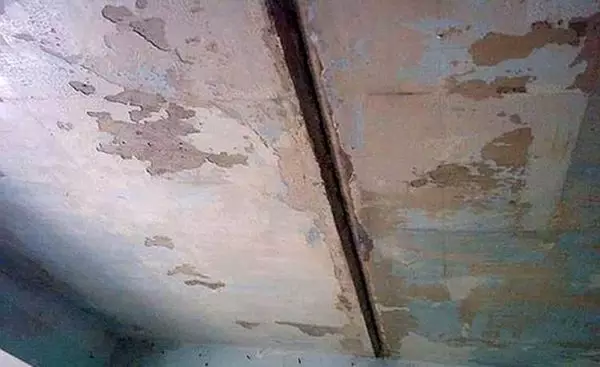
Such seams on the ceiling - not uncommon
After drying the impregnation (24 hours from the date of application) a solution is applied. If a layer is required more than 30-35 mm, it is better to apply it in two layers. Setting the first, the relief shape on it on it. After a day, when the solution serves, apply the second layer. It is already leveling in a ceiling.
With a large layer of plaster stakes, plates are sometimes reinforced by a layer of painter stacks. It is needed in order for plates during seasonal plates on the seam, there are no cracks. It is unlikely that someone will trigger the grid to the ceiling, it is usually easy to fit. In this case, after applying the first layer of plaster, a strip of a polymer plaster mesh is stacked, it is carried out by a toothed spatula, deepening it into the solution and, at the same time, forming a relief to apply the second layer.
Article on the topic: Curtains from PVC for arbors and veranda - perfect protection
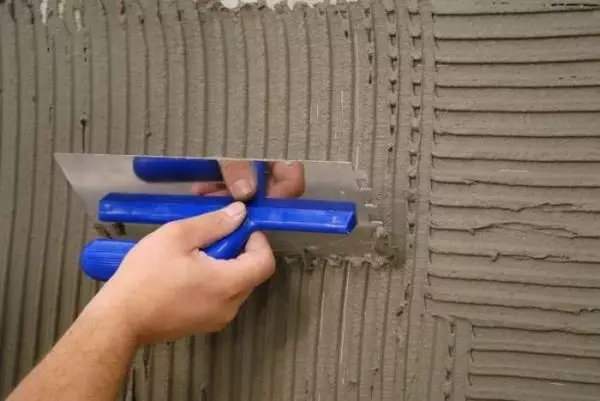
When applying plaster in two layers on the first form a relief
Sometimes the Rust (crack in the seam) is very deep and close it is not possible. It is also pre-cleaned from the sprinkled parts and sand, processed by "concrete contact". After there are two options:
- Close up by mounting foam. It is a little, about 1/3 of the volume of the slit, pre-abundantly moocked the wall with water (needed for normal foam polymerization). We leave for a day, after which they cut off the foam so that the plasterers in the seam fit at least 1 cm. After - soil and apply plaster in two (it is also three) layers.
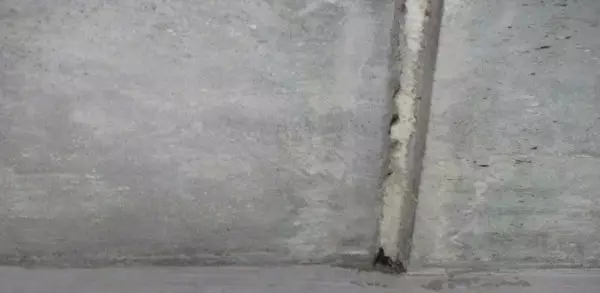
Keeping the ceiling with foam, you can wear a hose piece on the spout. So much easier to work
- Take the rag, moisten it with a concrete button, score into the gap. Leave for ducks, then shook out.
Maybe there may also be a question than to close the stakes of the plates on the ceiling. It is usually used one of the compositions with polymer additives, and you can also use good tiled glue. It also has a considerable amount of polymers. It is said that after such sealing the joints do not crack.
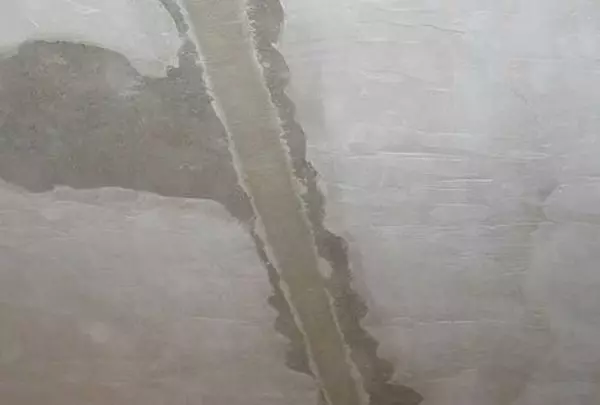
This looks covered with seam on the ceiling
Plaster ceiling for lighthouses do it yourself
If you ever placed the walls, you will be easier. The plaster of the ceiling though slightly different, but not dramatically. The greatest difficulty is that there are hands to keep raised up - they get tired, also tires the neck - comes to throw the head.Preparation
First, the ceiling is cleaned from all available finishing materials, up to bare concrete. After the surface remove dust. If there is a building vacuum cleaner (not household, it will throw), it is convenient to work for them, if not, just a large brush to remove all the dust and sand.
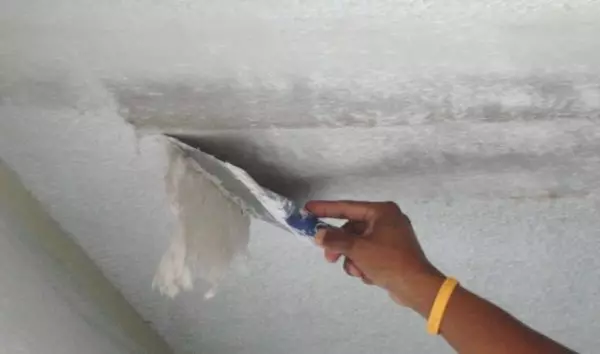
First we clean everything to pure material
If the ceiling is made of reinforced concrete plates with large rusts, they close them. After drying the solution in the rusts, primer is applied to the clean surface. After 24 hours of operation, you can continue.
Installation of Mayakov
The first stage of the ceiling plaster - installation of beacons, but first need to determine the maximum and minimum difference of heights. It is more convenient to do with the Laser Plane Builder. It is installed under the ceiling, turn on the scan of the horizontal plane. It is measured in a certain number of points measure the distance from the ceiling to the glowing beam. In this way, the maximum and minimum deviation is found. The thickness of the plaster layer should be a little more of the most significant deviation.
The same operation can be done with a water level, but it will be much more complicated. To begin with, it is necessary to apply horizontally around the perimeter of the walls at some arbitrary distance from the floor. One end of the level is fixed at this mark. With the second, we go around, moving the distance from the water column in the level - to the ceiling. So calculate the same maximum and minimum points.
Deciding with a layer thick, choose lighthouses. These are galvanized perforated sheets with a protruding back. These backs and will be supports when solving the solution. The height of the backrest can be 6 mm and 10 mm. Choose the one that is slightly larger than the maximum deviation found.
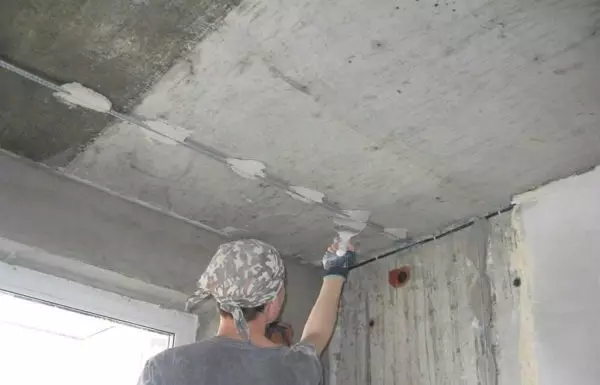
Installing beaches on the ceiling
Lighthouses are set in increments, slightly less than the length of the rules - the tool that is leveling and cut into the solution. With the length of the rule of 1.5 meters, the beacons are set at a distance of 1.1-1.3 m. Long work with unaccustomed is difficult, shorter - it is not worth it - too many seams. First put extreme lighthouses, retreating from the walls of 20-30 cm. The remaining distance is divided so that the distance between the beacons was at the specified framework.
Fasten the lighthouses on the gypsum solution, mix it thick. Upon installation line of the lighthouse (can be burned on the ceiling) is the islands of this solution. Lighthouses are pressed into it, exposing their backs in one specified plane. If there is a plane builder (level) everything is simple - exhibit on it - the beam must slide on the back.
If we work with a water level, we carry the required "clean" ceiling level on the walls, stretch several cords so that they are directed along the lighthouse. On these cords and insert the backs of the planks. By putting all the lighthouses, check the plane by the rule with a bubble level installed on it.
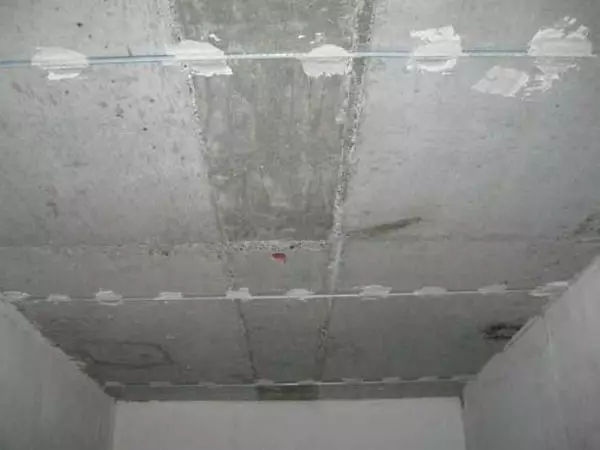
Distance between the beacons on the ceiling - 1.1-1.3 meters
After the gypsum grabs (there must be a few hours), you can begin the ceiling plaster.
Application and alignment of plaster on the ceiling
At this stage, it will require sustainable building goats with a large platform between them. From the tools - a small spatula and a building falcon - a playground with a handle.
Built the selected plaster mixture strictly according to the instructions. The solution should be homogeneous, without lumps. A solution is superimposed on the falcon from the tank, then with the help of a small spatula, the consignments are stacked on the ceiling. It is more convenient, probably to send a solution with a sharp movement of the brush, but you can simply "adjust" to the ceiling. Here everyone chooses its way.
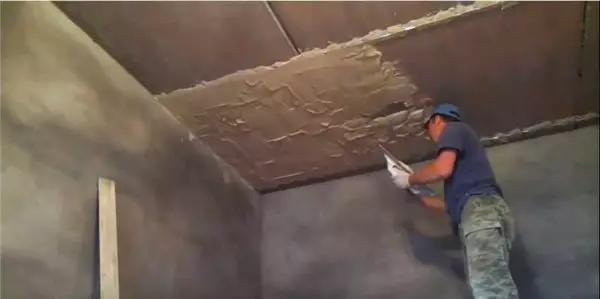
Fill the space between the beacons with a solution
Filled with plaster Distance from one lighthouse to another. The width of this strip for the beginning is 50-60 cm. When laying should not be achieved a homogeneous surface. It is filled with chaotic strokes.
We take the rule, lay it on the lighthouses, move to yourself, shaking from side to the side. With this movement on the bar, a certain amount of solution remains.
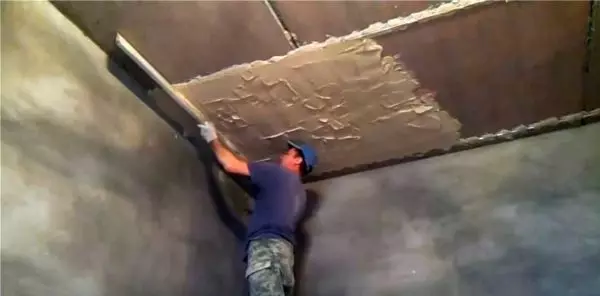
We take the rule, starting to smooth
He is removed by a small spatula and send it to the ceiling - on the unfilled part or where the pits were found. By filling out the pits, again pull the rule. These are the main techniques of the plaster ceiling, they repeat them until the site becomes smooth.
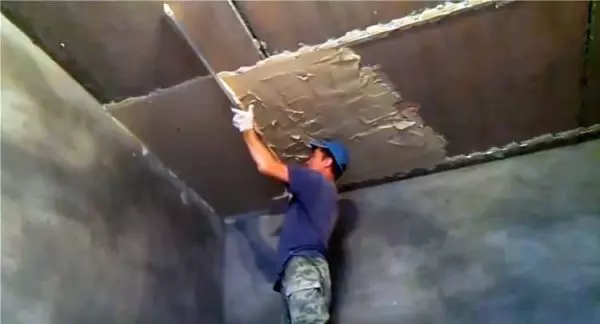
Stretch several times, filling the pits
So, gradually, one band is filled, then the second, and so - the whole ceiling. It is left to dry 5-8 hours.
Removing beacons and entry of rusts
When the solution grabbed, but not dry, the lighthouses take out. If you leave them, the metal will begin to rust, rusty divorces can appear on the ceiling.
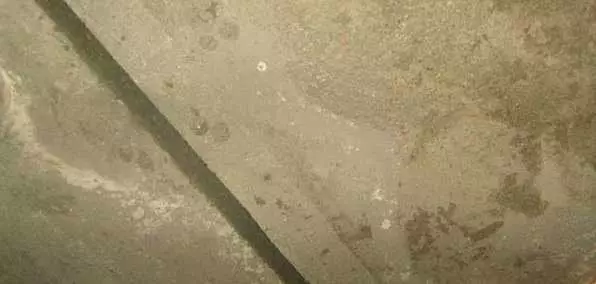
After removing the beacons, rusts remain, they are closed with mortar
The rules that remained after lighthouses are filled with the same solution, align in one level with the plane of the ceiling with a wide spatula. It makes sense to use melting - it is too long. After that, we can assume that the plaster of the ceiling is finished with their own hands. It remains to wait for her complete drying. It will take from 5 to 7 days - depending on the composition.
Article on the topic: Design kitchen-living room in a private house
